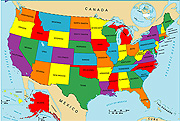
THURSDAY, Feb. 21 (HealthDay News) — The latest U.S. cancer statistics find that 1.5 million new cases of invasive cancer were diagnosed among Americans in 2009, with more men than women developing malignancies and blacks at higher risk for cancer than whites.
The U.S. Centers for Disease Control and Prevention report reveals a nationwide annual rate of cancer diagnoses of 459 cases per 100,000 adults, but incidence per state ranged widely, with higher rates for colon and lung cancers concentrated in the South.
Prostate, breast, lung and colon cancer accounted for more than half of the cancers (52 percent) diagnosed in 2009, the CDC said. The report noted that the differing rates of prostate and breast cancers largely account for the observed racial and gender variations.
New cancer diagnoses increased with age, with more than 2,200 cases reported per 100,000 people aged 75 and older. The rate for people 50 to 64 was less than half that — 843 per 100,000 individuals.
The 2009 data, derived from national cancer registries, does not include basal or squamous cell skin cancers or information from Wisconsin.
Many cancers are preventable, and breaking down their occurrence helps federal health officials to monitor trends over time and improve preventive efforts.
“Populations defined by state of residence, race or ethnicity with high rates of cancer might benefit most from targeted cancer prevention and control efforts,” the researchers said in the paper, which was published in the CDC’s Morbidity and Mortality Weekly Report.
The overall cancer rate among men was 524 new cases per 100,000 people, with prostate cancer being most common, followed by lung and colon cancers. In Hispanic men, however, that order was reversed, the CDC said.
U.S. women had 414 new cases of cancer per 100,000 people in 2009. Breast cancer led the diagnoses, followed by lung, colon and uterine cancers. Hispanic women, however, had more cases of colon cancer than lung cancer.
There was one spot of bright news: The federal government’s Healthy People 2020 goals have called for a reduction of colorectal cancers to 38.6 cases per 100,000, and the new report shows that the goal has already been met among women nationwide and among both genders in some states.
Cancers overall were more common in the Northeast and less common in Florida, the Southwest and California. But certain cancers were more prevalent in one region than others. For instance, lung cancer prevalence was greatest in Southern states, and colon cancer seemed concentrated in the South and Midwest. Breast cancer diagnoses were most common in the Pacific Northwest, the upper Midwest and parts of the Northeast, the report found.
More information
HealthyPeople.gov talks about U.S. national health goals.

